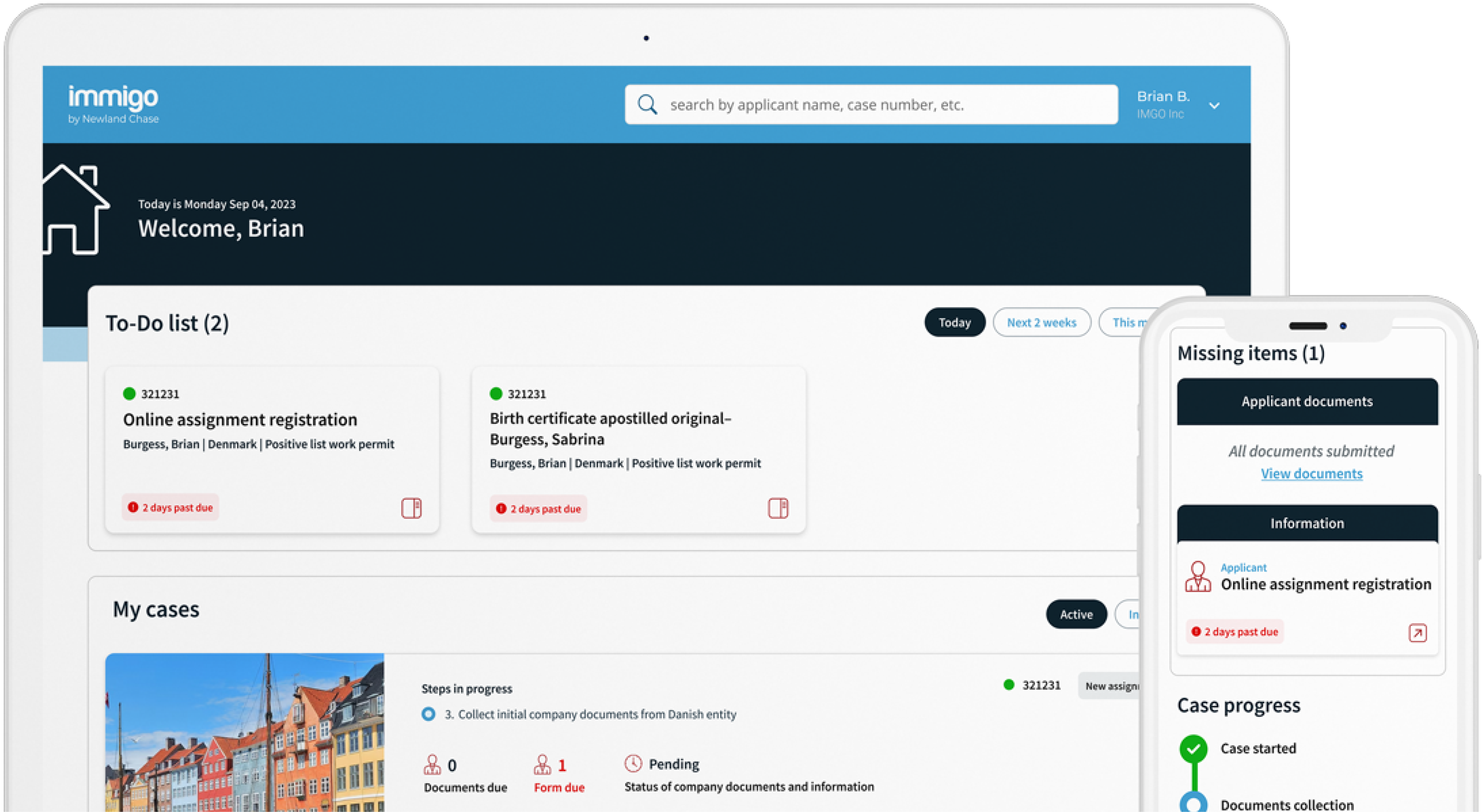Get The Visibility Your Company Needs
Reduce compliance risks and mobility costs while managing individual and project-related travel with ImmiSMART: the solution that unifies your travel and mobility programs.
Global Immigration 101: A Work Permit by Any Other Name
June 8, 2018
For successful mobility managers, school is always in session. In an industry where the only thing that is constant is everything is always changing… success depends on continually keeping abreast of new immigration rules and processes… and reminding ourselves of the same old basics vital to successful international assignments.
Whether you’re a “PhD” with years of handling your company’s international workforce… or the “new kid in class”, Newland Chase has you covered. Follow our continuing Global Immigration 101 blog series as each month we take a look at a different basic but vital aspect of immigration for short-term and long-term international business and work assignments. No tuition bills, student loans, number 2 pencils, term papers, end-of-semester exams, or all-nighters… just practical information and sage advice from the “real world” of mobility. (You’re welcome.) If you missed last month’s class on “Business Visa or Work Visa?”… you can copy my notes here.
In this month’s session, we cover that basic staple of mobility management… work permits… or at least as much as we can cover in one class period.
What’s in a Name… a Rose by Any Other Name?
Shakespeare had something… if it smells like a rose, it probably is one, regardless of what you call it (or something like that). While it is the official name in many countries, “Work Permit” is the most oft-used and almost generic term for the legal authorization required for foreign nationals to work in countries where they are not citizens. Other terms in various countries may be “work visa”, “work license”, “employment visa”, “employment permit”, “work pass”, “employment pass”, work or employment “papers”… and the ever-popular “terms of art” and acronyms like “Blue Cards”, “ICTs”, “IMTAs”, etc. Regardless of its name, a good rule of thumb for mobility managers is… if it comes from that country’s labour department, it’s probably the work permit (or at least the formal approval you need to get one). Which brings us to the typical applications process.
A “Typical” Applications Process?
Just as the official names vary from country to country, so do the processes and requirements for obtaining work permits. While the agencies involved and order of steps vary, most countries’ road to a work permit goes through both labour authorities and immigration authorities. Most often, the first step is an in-country process with local labour authorities examining the details of the work to be performed, the applicant’s qualifications, and the employment conditions. Once approved by the labour authorities, the process then moves on to immigration and consular authorities.
However, in other countries, the formal start of the process may be application submission at the country’s overseas consular post or visa processing centre in the employee’s country of residence, with the consular officials engaging the labour authority. In either instance, the resulting final product (the “work authorization”) may come either in the form of separate work permit and entry visa or in the form of a single combined work/entry visa (oftentimes with residence authorization).
Putting that into a nice information-packed, professional-looking flow chart, it looks like this:

Applications for work permits can come in the form of either paper application or electronic field-fillable online submissions to labour authorities, immigration departments, and overseas consular posts. Increasingly, most of the process is now electronic, with both companies and employees submitting their pieces through online platforms and sending and receiving communications with authorities.
As for application requirements, along with completing the application form, companies and employees will be required to submit originals, paper copies, or scans of various documents which can typically include:
- Employee’s citizenship, naturalisation, and immigration documents – passports (sometimes including former passports), government-issued ID cards, birth certificates, current visas, past visas from the same country, residence permits or permanent residence cards;
- Employment documents – employment contracts (showing salary), invitation or assignment letters, letters showing a required tenure with the company;
- Company information – incorporation and registration documents, financial statements, tax filings;
- Criminal background clearances – from the employee’s country of residence and possibly other countries where the employee has been a resident;
- Qualifications of the employee –university degrees, certificates, professional licenses, CV/resumes;
- Medical information – including results of medical exams, immunization records; and
- Family information (if spouses and/or children are accompanying) – including marriage certificates, birth certificates, adoption papers, and any of the above documents pertaining to spouses and children.
Depending on the country, some of the above may need to be legalised, apostilled, certified, attested, etc. (but more on all that in a future “Global Immigration 101” blog). Also depending on the country, “biometrics” such as photos, fingerprints, and possibly eye-scans may either be collected at the overseas consular post or visa processing centre or in-country upon arrival.
A Labour Market “Test”…TODAY?!?
Having degrees in economics and law and no degree in corporate immigration… the first time this blog writer learned that my corporate client was required to do a “Labour Market Test” before they could hire an Indian engineer… I almost fainted, “Geez… how long is that gonna take, and how much will it cost?!?” Flashbacks of pouring over stacks of labour department statistical publications in the university library to finish 11th hour economics term papers gripped me with fear.
To assuage any trepidation… not every country requires LMTs (labour market tests), and many countries have lists of in-demand occupations exempt from LMT requirements. Moreover, where a LMT is required, it is most-often simply a requirement to advertise the open position in the local market before recruiting a foreign candidate abroad. (Maybe they should give it a less intimidating name? Just a thought.) Usually there will be a specific number of days or weeks (generally 5 to 30 days) the open position must be advertised. There is likely to be requirements as to which website or publication the advertisement must be placed (sometimes more than one), and there may be requirements as to the content of the advertisement, such as description, salary, qualifications, etc.
And in the event that a local candidate applies… there may be specific requirements on documenting how the candidate was considered (CV/resume, applications, interviews, evaluations) and the justification of why the candidate was not selected over recruiting a foreign candidate. Note that LMTs and local hiring requirements are an aspect of global corporate immigration that is highly evolving and subject to frequent changes. In many countries, a greater emphasis is being placed on encouraging local hiring.
Minimum Salaries… a Rose May Not Actually be a Rose?
Many countries have minimum salaries that must be paid to foreign employees in order to be eligible for work permits, oftentimes at or significantly above the prevailing local wage for the same occupation. However, be aware that “salaries” may or may not include other remuneration: such as housing allowances, travel allowances, reimbursements for travel, etc. There may also be requirements in some countries as to the currency (foreign or local) and mode (local bank account) that the salary must be paid.
Like the LMTs above, the primary purpose of the minimum salary requirements is to protect the local labour force by preventing companies from unfairly importing cheap labour. Also, like LMTs, this is an aspect of the process subject to frequent changes in salary amounts and implications. The applicant’s salary may determine a variety of immigration aspects – including strict eligibility (and sometimes waivers) of the work permit, eligibility to sponsor accompanying family for dependent visas, points awarded in competitive visa/permit decisions, and other benefits.
Quote the Quotas?
In many countries (but certainly not all), quotas or caps on the number of work permits issued yearly or monthly may apply. Quotas may be applied across the board in all cases, or they may be based on the type of work permit or length of assignment, based on occupations, apply only to salary levels below a threshold amount, or be based on the applicants’ nationality. The current trend toward increased emphasis on local hiring also makes this aspect of immigration subject to frequent changes. However, in many countries, there may be no quotas or caps at all.
Other countries take a different tack to managing the level of foreign workers admitted into the country. “Shortage Occupations Lists” designating only certain in-demand occupations as eligible for work permits may exist, with applicants in other occupations being wholly ineligible for work permits. These lists are often based on nationally or internationally excepted job classification codes, such as the U.S.’s Standard Occupational Classification (SOC) Codes or the Australian Standard Classification of Occupations (ASCO). Occupations are periodically added or removed from the lists as demand for certain occupations fluctuates in the local job market.
Permanently Temporary or Temporarily Permanent?
Technically, most work permits are “temporary”, i.e. with a limited validity and often renewable for another limited period(s). But that doesn’t mean the employee on a “temporary” work permit can’t become permanent. Surprisingly, in some countries a temporary work permit can be renewed continuously an unlimited number of times… especially if the employee is in a highly-skilled or high demand occupation or highly-compensated. (Sounds a lot like permanent, doesn’t it?) In most instances (but not all), years resident in the country on a temporary work permit can be counted toward a subsequent application for permanent residency.
Well, the “clock on the wall” is saying that this week’s class is quickly drawing to a close… Our apologies to the most studious of our readers… this blog clearly only scratched the surface of work permits. But hopefully some readers will find the quick overview/introduction/reminder useful and the basis for more in-depth future discussions… including more on some of the topics only touched upon today.
Rest assured, we’ll be back next month (and many months to come) with more riveting Global Immigration 101 topics as we venture further into our syllabus. Watch for next month’s edition in this continuing blog series on the Newland Chase website at https://blog.newlandchase.com/. To have alerts on corporate immigration law changes from around the world delivered once a week to your inbox, subscribe to our newsletter at the bottom of this page.
This blog was prepared by the team at Newland Chase. It is informational only and is not intended as a substitute for legal advice based on the specific circumstances of a matter. Readers are reminded that immigration laws are fluid and can change at a moment’s notice without warning or notice. Please reach out to your Newland Chase contact should you require any additional clarification or guidance. Written permission from the copyright owner and any other rights holders must be obtained for any reuse of any content published or provided by Newland Chase that extend beyond fair use or other statutory exemptions. Responsibility for the determination of the copyright status and securing any permissions rests with those persons wishing to reuse this blog or any of its content.




